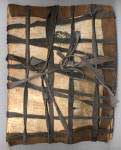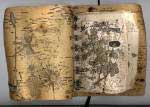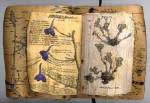Short info (sorry for my poor english...)
Here just a very few infos about origin and making of this little book, it's completely made of the bark of dead (!) birch trees. I made it in 1997 as a little side lining during a unforgettable four month long stay in Siberia. It was during my studies (landscape planning) when I worked for one of the most important siberian NGO environmental groups: Baikal Environmental Wave (==> read my reference)
The making of the book was mostly influenced by marvellous impressions inmidst the stunning siberian nature around Lake Baikal. I was able to take part at several excursions with russian friends and botanists. This time was just unforgettable!
==> Basic infos about Lake Baikal (Siberia) from Wikipedia

Making of the birchbark book
The whole idea had no external inspiration, all ideas just evolved from step to step by the materials I had and the impressions of nature and landscape. I never had heared before of making a book from birch bark before or after, but now I know birch bark was a very important material for the indigenous tribes of the northern hemisphere for thousands of years.
Next to a small burjatian village called Katchergat I collected thin layers of bark from dead birch trees. It was pressed and dried. I formed a stable cover, then the single pages were cutted and bonded with traditional bone glue. At last the complete bundle was sewed up with strong yarn, bone glue and finally attached to the strong cover. The whole book is very stable. Some stitchings got the shape of an abstracted chain of bees. You can see it if you look at the middle of the first page:
After making the cover and the empty pages all components were bonded to a real birchbark book. Then the design of the single pages started. Each has its own story and a unique layout. For example there is a story of an thrilling observation of a hunting peregrine falcon who successfully captured a crow next to an impressive 80 meter high undercut slope at the Irkut river. The observation is titled "Der Falke von Schamanka" (The Falcon of Shamanka). Shamanka is the name of a burjatian village closely by. The story is written on the left side of this page:
Materials and drawings
Inside the book you'll find a mixture of dried plants, stones, bones of animals and many more. Everything was found in the wilderness of the east siberian nature. Last but not least there are lots of abstract drawings with black ink. I made them with an extra fine black ink tubular drawing pen (0.22 and 0.13 mm diameter). They show a mysterious world of life, maybe just straight from the depths of Lake Baikal or insects from the steppe island Olchon. Some of these drawings symbolize abstracted ecoLogical observations.
As a very effective protection all the materials inside were covered with a layer of a special transparent bone glue. Result: you can use the book without worry to destroy the filigree work.
Closing the book
 At last I attached
two strong leather strings at the book, with them I can tie up the whole thing
very stable and compact. When the book is closed and the leather strings are
knotted it looks really special... ;-)
At last I attached
two strong leather strings at the book, with them I can tie up the whole thing
very stable and compact. When the book is closed and the leather strings are
knotted it looks really special... ;-)
Size of the closed book: 18 x 12 cm and about 1.5 cm thick. The book has 11 sheats with 22 individual styled pages.
I hope this little online version gives you an idea of my siberian birchbark book...
Products made of birchbark:
http://www.nativetech.org/brchbark/
Just today (2005-01-15) I discovered a very interesting site with very old russian Birchbark Letters! http://humanities.uchicago.edu/depts/slavic/bblphotos.html
And check this: http://www.albertasource.ca/boreal/the_traditions/birchbark.html
Or this: http://www.birchbarkcanoe.net/

